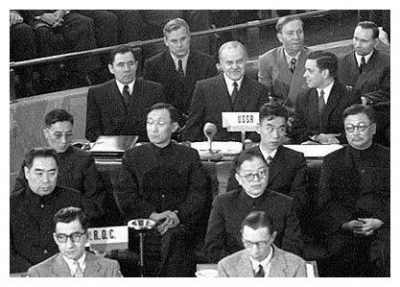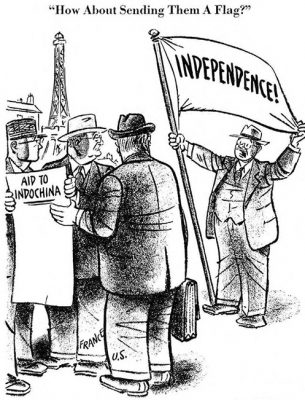what were the provisions of the geneva accords agreed to in 1954

In Apr 1954, diplomats from several nations – including the United States, the Soviet Union, China, French republic and United kingdom – attended a conference in the Swiss city of Geneva. This led to the creation of the Geneva Accords, which outlined a roadmap for peace and reunification in Vietnam. The Geneva Accords are remembered as a failure, chiefly because major nations did not adhere to their terms.
The Geneva summit
The Geneva gathering had in fact been convened to discuss two other Cold War hotspots, Berlin and Korea. By the time it began, the Viet Minh had overrun the French base at Dien Bien Phu, forcing Vietnam onto the agenda.
By the start of May, Paris had announced its intention to withdraw from Indochina and dismantle the colonial administration there. The French withdrawal would leave Vietnam without an established national authorities, placing information technology at risk of a communist takeover.
The Geneva conference was given the unenviable job of arranging for Vietnam's reunification and self-authorities. The conference produced a set of resolutions known every bit the Geneva Accords, a roadmap for Vietnam's transition to independence. The Accords were not supported by major players, however, and so had little chance of success.
Parallels with Korea
The delegates at Geneva noted similarities between Vietnam and mail-war Korea, a country also left divided after Globe War 2.
Until 1945, Korea had been occupied by the Japanese. After their withdrawal, the Korean peninsula was divided at the 38th parallel. This division was intended to be temporary, however, the region before long firmed into two separate states: communist-controlled North korea, backed by the Soviet Union and China; and Due south Korea, backed by the United States and its Western allies.
The rulers of both these transient states idea themselves the rightful rulers of the entire peninsula. In 1950, North Korean troops launched an invasion of the South, triggering an international response. A United nations armed forces coalition led past the United States intervened to forestall Southward Korea from being overrun. A ceasefire ended the Korean State of war in July 1953 with the peninsula all the same divided.
A temporary division

The Geneva conference adopted a similar arroyo in Vietnam. Vietnamese territory would be divided temporarily into north and south, so given a road map to free elections, self-authorities, reunification and independence.
Unfortunately, the plan hatched at Geneva was undermined and sabotaged by a lack of support. American delegates attended the Geneva peak but scarcely participated. United states Secretarial assistant of State John Foster Dulles, a vehement anti-communist, refused to recognise, milk shake easily with or speak direct to Chinese or Viet Minh delegates.
In that location was besides sectionalisation and disagreement in the communist bloc. Both People's republic of china and the Soviet Wedlock, for their own strategic reasons, refused to back the Viet Minh claim to govern all of Vietnam. Ho Chi Minh's chief negotiator, Pham Van Dong, chose not to marshal also closely with Moscow or Beijing, preferring that Northward Vietnam remain in charge of its own destiny.
British consul Sir Anthony Eden later remarked that he had "never known a briefing of this kind… the parties would not make directly contact and nosotros were in constant danger of one or some other backing out the door".
Terms of the Geneva Accords
The Geneva conference took until July 21st before it produced a formal agreement. Among the terms of the Geneva Accords were the following:
- Vietnam would go an contained nation, formally ending 75 years of French colonialism. The old French colonies Kingdom of cambodia and Laos would besides be given their independence.
- Vietnam would exist temporarily divided for a period of two years. The temporary border was fixed at the line of latitude 17 degrees north of the equator, also known as the 17th parallel. The border was intended to "settle military questions with a view to catastrophe hostilities … the military demarcation line is provisional and should not in any fashion be interpreted as constituting a political or territorial boundary".
- Nationwide elections were scheduled for July 1956. They would be conducted under international supervision. The ballot result would make up one's mind the political organization and regime in the newly independent Vietnam.
- During the two year transition period, war machine personnel were instructed to return to their place of origin: Viet Minh soldiers and guerrillas to North Vietnam, French and pro-French troops to Southward Vietnam. Vietnamese civilians were gratuitous to relocate to either North or South Vietnam.
- During the transition flow both North and S Vietnam agreed not to form any strange military alliances or authorise the construction of foreign armed services bases.
Outcomes of the Accords

On the surface, the Geneva Accords appeared a sensible solution to a difficult trouble. The Accords generated some optimistic press coverage and hope that Vietnam could be stabilised and eased into independence.
In reality, the Accords were almost certainly doomed to neglect. They were hastily drafted and rushed into existence barely two months after the autumn of Dien Bien Phu. The Geneva conference was an acrimonious matter undermined by Cold War tensions and mistrust. The Accords were not negotiated in good organized religion: many stakeholders either refused to sign or signed under pressure.
Both South Vietnam and its main benefactor, the Usa, "acknowledged" the Accords only refused to sign them or commit to honouring their terms. The Viet Minh delegates did not wish to sign: they were sceptical almost the scheduled 1956 elections and reluctant to concur to the 17th parallel border, which would mean surrendering territory to the Due south. In the terminate, the Viet Minh representatives signed on the instructions of Ho Chi Minh, who was himself nether pressure from the Soviet Spousal relationship and China.
American bookish Roger H. Hull attributes the failure of the Geneva Accords to the lack of expert faith and consensus among those who attended the summit:
"That the end envisioned past the 1954 accords (peace) proved elusive was not due to the means by which peace was to be attained. The fatal defect was to be found in the fact that the accords were non confirmed or assented to by all of the parties to the conflict. The Us and the S are not leap by the Accords, since they not only refused to sign… or endorse orally the proclamation simply as well stated affirmatively their opposition."
Roger H. Hull, U.s.a. lawyer
Operation Passage to Freedom
The Geneva Accords likewise provided a 300-solar day grace period, and so that civilians could relocate to N or South Vietnam. The United States began providing assistance to those Vietnamese who wanted to movement south. A joint US-French naval chore force was assembled almost Haiphong Harbour, while US personnel and assist workers organised refugee camps, food and medical supplies in South Vietnam.
This process – pointedly titled Functioning Passage to Freedom – was role-humanitarian mission, part-propaganda ploy. American politicians described it every bit the generous act of a benevolent superpower, fulfilling its moral obligation to assist freedom-loving people.
Approximately 660,000 Vietnamese chose to relocate from N Vietnam to the S; almost half of them did so aboard American ships. Many southbound refugees were frightened by rumours that the Due north intended to slaughter Catholics. Around 140,000 Vietnamese also moved in the reverse direction, s to north, with picayune or no assistance.

1. The Geneva Accords refer to a series of agreements pertaining to the time to come of Vietnam. They were produced during multilateral discussions in Geneva between March and July 1954.
two. The discussions at Geneva were marred by Cold War paranoia and mistrust. Delegates from some nations refused to negotiate directly, while the United States and South Vietnam refused to sign the Accords.
three. Under the terms of the Geneva Accords, Vietnam was divided at the 17th parallel for a period of ii years. Complimentary elections were scheduled for July 1956 to decide the government of reunified Vietnam.
4. Both soldiers and militia from North and S Vietnam were instructed to return to their identify of origin, while Vietnamese civilians were gratuitous to relocate to the northward or south.
5. In 1954-55 the United States launched Operation Passage to Liberty to assist Vietnamese civilians with relocating from north to south. Information technology was a humanitarian mission but also served as propaganda.
Commendation information
Title: "The Geneva Accords of 1954"
Authors: Jennifer Llewellyn, Jim Southey, Steve Thompson
Publisher: Alpha History
URL: https://alphahistory.com/vietnamwar/geneva-accords-of-1954/
Appointment published: June 15, 2019
Appointment accessed: March 17, 2022
Copyright: The content on this page may not be republished without our express permission. For more than information on usage, please refer to our Terms of Use.
drinkardexpeconen.blogspot.com
Source: https://alphahistory.com/vietnamwar/geneva-accords-of-1954/
0 Response to "what were the provisions of the geneva accords agreed to in 1954"
Post a Comment